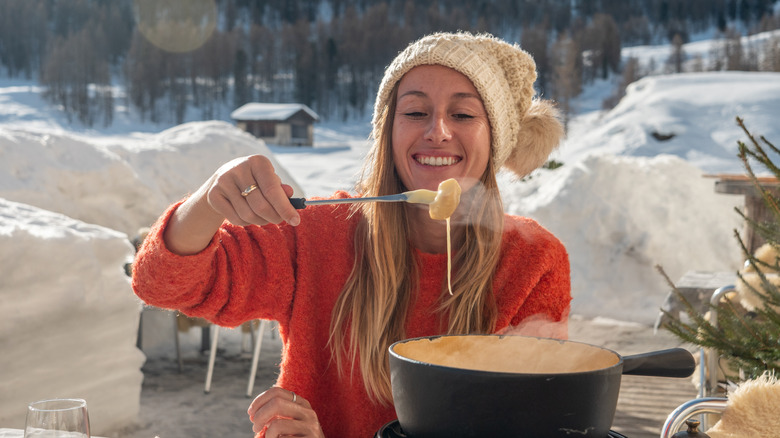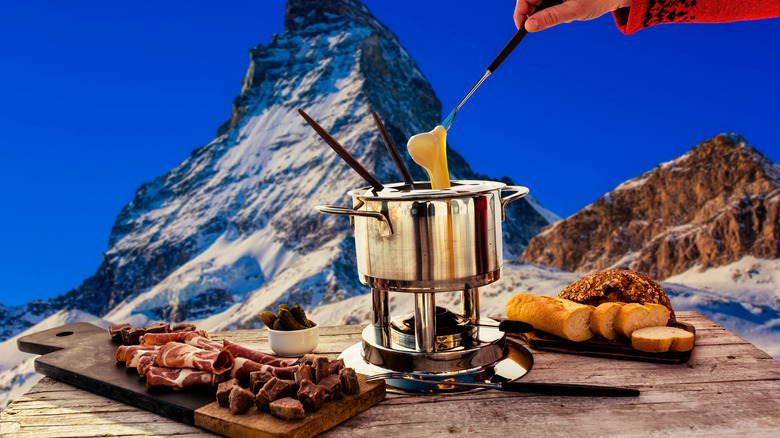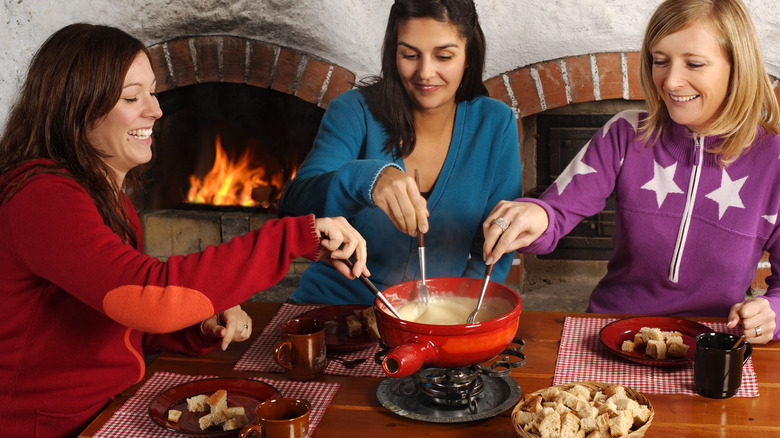There Are Only Three Beverages Tourists In Switzerland Should Order With Their Fondue
Switzerland is a destination that sits at the top of many bucket lists — there's something for every type of traveler. History buffs will love exploring the gorgeous historic cities of Bern, Zurich, and Geneva, or discovering enchanting castles on the shores of the sparkling Lake Geneva. Nature lovers will adore the breathtaking natural scenery in areas like Interlaken and Grindelwald. Winter sports enthusiasts will find no shortage of opportunities to ski and snowboard through the Alps at some of the most popular European ski hot spots. With all of this combined, it's the best destination for outdoorsy families.
Regardless of what initially inspires you to plan a trip to Switzerland, it would be a crime to leave without sampling some of the delicious local delicacies during your trip. Culinary travel is a top trend in 2024, and the Swiss are known for producing some of the world's finest flavors. World-famous chocolate delights those with a sweet tooth, and wine-making traditions date back around 2,000 years, but the most exquisite culinary marvel of all is probably the delectable goey fondue. According to local lore, there are only three things you should drink while indulging in the mouthwatering Swiss dish: white wine, kirsch, or herbal tea.
The history of fondue
Fondue is more than a meal in Switzerland — it's a whole culinary experience. The tasty dish originated in the 18th century, and its name is derived from the French word "fondre," which means "to melt." Like many of the world's best culinary inventions, fondue was created out of necessity. It offered Alpine farmers and their families a hearty meal throughout the winter months, when other food sources were scarce. Cheese was able to be stored for long periods of time, and when warmed over the fire and served with bits of bread for dipping — simple ingredients were transformed into something delicious.
The traditional food is still enjoyed throughout Switzerland and is beloved by locals and tourists alike. Today, most recipes call for Gruyere, a rich semi-hard Alpine cheese of Swiss origin that tastes creamy, salty, and a little nutty. It's usually paired with other cheeses like Emmentaler or raclette along with wine, garlic, and herbs to create a delicious melty blend and served alongside small pieces of bread, potatoes, and pickled onions. You'll find the dish served all over Switzerland with plenty of local variations. It's served year-round, although the Swiss particularly love to eat it during the winter. The last bit of the fondue left at the bottom of the pot is traditionally allowed to harden into a crispy brown crust, which is a particularly delicious treat at the end of the meal. Just try to avoid making this silly fondue mistake that'll out you as a tourist.
How to enjoy fondue like a local
Fondue is delicious, but it's a rich meal. Many cheese lovers learn the hard way that over-indulging can cause uncomfortable indigestion. The Swiss believe that the problem can be avoided by choosing the right beverages to enjoy with your meal. Locals swear by drinking specific beverages and insist on avoiding cold drinks so that the cheese doesn't solidify in the stomach. The most common beverage choice is a dry white wine, which they believe helps with digestion. Similarly, kirsch, a German brandy made from morello cherries, is often enjoyed as a shot along with the fondue. Herbal tea is also an acceptable and traditional alternative for those who don't wish to consume alcohol.
Fondue eating has its own etiquette rules in Switzerland, too. First, don't partake in the group fondue eating experience if you're fighting off an illness, since it's a shared pot. Fondue utensils include a long spear-like fork, which is used for dipping bread into the pot of melted cheese. You should then place the bite on your plate and eat it with regular silverware, as opposed to eating it directly off of the fondue-fork. And never double-dip. With each bite, dip your bread all the way to the bottom and give the pot a good stir — either in a large circle or in a figure eight pattern. Before moving your bite to a plate, give it a little twirl to get rid of any excess cheese so you don't make a mess on the table.


